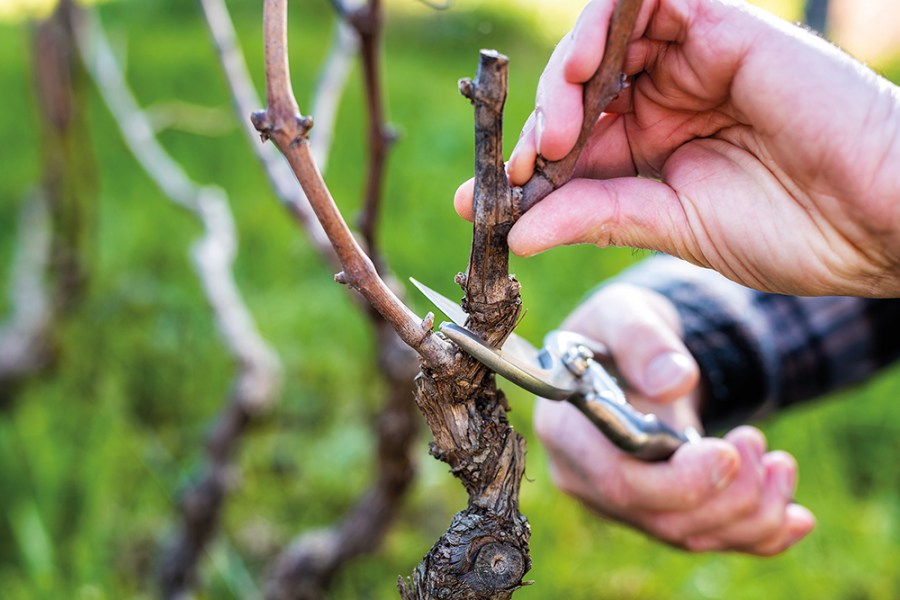Effective pruning sets vines up for the season ahead.
Pruning typically costs around £1,250 per hectare, and for many sites it is the single biggest manual task to be completed.
The preferred approach depends on the growing system used, labour availability and the number of vines to be pruned. The main judgement when pruning is not so much about what is removed, more about what is left behind. Generally look for canes that are well positioned, have appropriate bud spacing, are approximately pencil-size in diameter and healthy nut-brown in colour, and free of diseases such as powdery mildew or Phomopsis.
Mature vines that carried little crop this year will have more growth than recently planted vines, or those hit by spring frost, where the choice of material will be constrained. On vigorous vines, leaf fall will need to happen before cane selection can commence.
Bud number is a useful guide to pruning. Vines grown on the Geneva Double Curtain (GDC) system are typically pruned back to two to three buds per spur, while those on the Guyot system may retain eight to 12 buds per cane, and for the Scott Henry system it is nearer five to eight.
It may not always be practicable to count buds before making every cut; internodal distances are not uniform and vary due to cultivar, rootstock, site and cultivation, so bud counts are often adapted to maximise potential fruiting area.
An alternative approach is to base pruning decisions on cropping potential of individual vines, considering their age, trunk diameter, vigour, length of growth and general health.
Well-established mature vines can usually lay down enough canes to bow down onto the fruiting wire, and for particularly strong plants, the Pendelbogen training system (“European Loop”) may be an option. This involves laying down canes in an arc to reduce the ‘apical’ dominance of the most distal bud that can occur in canes laid horizontally. Arching can promote better sap distribution and produces more fruit-bearing shoots, but will require an extra wire over which to loop the canes.
It is generally better to be conservative when removing material, especially given the frosts of 2020, so this may mean allowing more buds, leaving sacrificial canes, or delaying tying down, especially on frost-prone sites. You can always return later to trim more, rather than end up short of material having pruned too much. For plants that were slow to recover from frost damage this spring, growers will have to work with what they have, which may not be ideal.
The ‘gentle pruning’ principles promoted by Simonit and Sirch follow a clear logic and are gaining increased adoption in the UK. Briefly, they are:
1. Branching – developing a branch structure to respect the vine’s natural growth habit
2. Respecting vascular flow – thinking about the ‘plumbing’ and recognising every cut potentially leads to a ‘desiccation cone’, (an area of die-back inside the crown) that reshapes the plant’s vascular system
3. Cuts and crowns – developing the crown and trying to avoid cutting into wood that’s more than two years old. Making only small cuts reduces the area of wood exposed, so reducing the risk of trunk disease
4. Protective wood – leaving a small stub when cutting into two year old wood, to further protect the crown and preserve sap flow.
Where unavoidable, larger cuts (2.5cm+) benefit from being protected from infection while they heal. Bloccade is a useful sealant product, while Solufeed Garlic Barrier has also been beneficial against some grapevine trunk diseases. At the time of writing, Belchim looks like it may win CRD approval as a biological-based product for sealing pruning cuts.
Burning material straight away reduces disease carryover risk, but inoculum may still be present on remaining canes, wires and supports, providing a potential infection bridge that needs protecting against next spring.
Alongside crop protection products, remember that Hutchinsons also supply essential equipment needed for winter maintenance, including secateurs, wire, stakes, ties and more.
ww.hlhltd.co.uk • information@hlhltd.co.uk • 01945 461177




